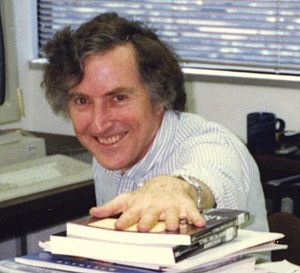Bob Braden facts for kids
Quick facts for kids
Bob Braden
|
|
|---|---|
 |
|
| Born |
Robert Braden
28 January 1934 |
| Died | April 15, 2018 (aged 84) |
| Alma mater | Cornell University Stanford University |
| Occupation | Computer scientist |
| Scientific career | |
| Fields | end-to-end network protocols |
| Institutions | Carnegie Mellon University University of California, Los Angeles Internet Configuration Control Board |
Robert Braden (born January 28, 1934 – died April 15, 2018) was an American computer scientist. He played a very important role in helping to build the Internet as we know it today. He focused on how computers talk to each other. This included the special rules, called protocols, that make sure information travels safely across networks.
Contents
Bob Braden's Journey in Computer Science
Robert Braden studied at two famous universities. He earned a degree in Engineering Physics from Cornell University in 1957. Later, in 1962, he received a Master of Science degree in physics from Stanford University.
Early Work and Teaching
After finishing his studies, Braden worked at Stanford and Carnegie Mellon University. He enjoyed teaching students about computer programming. He also taught about operating systems, which are the main programs that run computers. He taught these subjects at Stanford, Carnegie Mellon, and later at UCLA.
Braden spent 18 years working at UCLA. For 16 of those years, he worked at the university's main computer center. In 1981 and 1982, he spent time at the Computer Science Department of University College London in the United Kingdom. While there, he created the first system that connected the Internet with the U.K.'s academic X.25 network. This was a big step in linking different computer networks together.
Joining the Internet Pioneers
In 1986, Braden joined a special research group at the Information Sciences Institute (ISI). This group focused on computer networking. He became a project leader in their Computer Networks Division. His hard work and contributions were recognized in 2001 when he was named an ISI Fellow. This is a high honor for researchers.
Braden's Big Contributions to the Internet
Robert Braden made many key contributions that helped shape the Internet. His work helped create the systems and rules that allow computers worldwide to communicate.
Connecting Early Networks
While at UCLA, Braden was in charge of connecting UCLA's powerful IBM 360/91 supercomputer to the ARPANET. This happened in 1970. The ARPANET was an early version of the Internet. He was very active in the ARPANET's Network Working Group. He helped design the File Transfer Protocol, which is still used today to send files over the Internet.
Developing TCP/IP
In 1978, Braden joined the Internet Working Group. This group was developing TCP/IP, which are the main rules (protocols) that the Internet uses to send data. He started creating a TCP/IP system for UCLA's IBM computer. This software was shared with other computer centers. Later, it was even sold as a commercial product.
Leading Internet Organizations
In 1981, Braden was invited to join the Internet Configuration Control Board. This group later became known as the Internet Architecture Board (IAB). The IAB helps guide the development of the Internet. Braden served as a member of the IAB for 13 years.
He was also a member of the Internet Engineering Task Force (IETF) and the Internet Research Task Force (IRTF) from their very beginning. These groups work on new Internet technologies and research.
Key Projects and Standards
In 1986, Braden created the End-to-End Task Force. This group later became the IRTF End-to-End Research Group. He led this group for many years. Some of his important contributions during this time include:
- Helping to write the Host Requirements RFCs. These are important documents that explain how computers should connect to the Internet.
- Developing the Resource Reservation Protocol. This helps ensure that data, like video calls, gets enough network space.
- Developing T/TCP, a faster version of TCP.
- Serving as a co-editor for the Request for Comments (RFC) series. RFCs are official documents that define how the Internet works.
- Working with the Internet Assigned Numbers Authority (IANA). This group manages Internet addresses and names.
- Coordinating the DARPA research network called DARTnet.
Braden was also a Fellow of the ACM. This is a respected honor for computer professionals.

